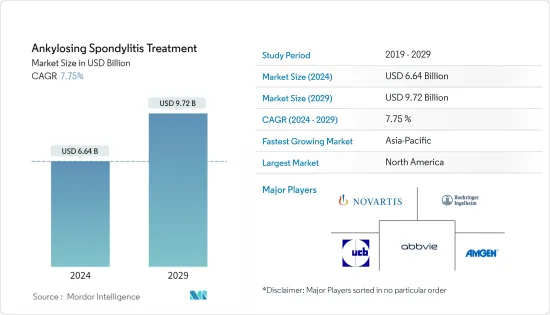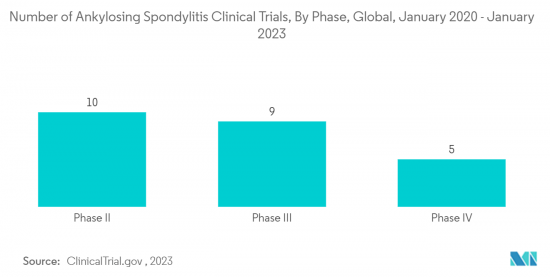
|
市場調査レポート
商品コード
1406983
強直性脊椎炎治療:市場シェア分析、産業動向・統計、成長予測、2024年~2029年Ankylosing Spondylitis Treatment - Market Share Analysis, Industry Trends & Statistics, Growth Forecasts 2024 - 2029 |
||||||
カスタマイズ可能
適宜更新あり
|
|||||||
| 強直性脊椎炎治療:市場シェア分析、産業動向・統計、成長予測、2024年~2029年 |
|
出版日: 2024年01月04日
発行: Mordor Intelligence
ページ情報: 英文 120 Pages
納期: 2~3営業日
|
全表示
- 概要
- 目次
強直性脊椎炎治療市場規模は2024年に66億4,000万米ドルと推計され、2029年には97億2,000万米ドルに達すると予測され、予測期間中(2024年~2029年)のCAGRは7.75%で成長する見込みです。

COVID-19の大流行は、さまざまな臨床研究やサプライチェーンの混乱により強直性脊椎炎市場に影響を与えました。COVID-19は免疫抑制剤を服用している強直性脊椎炎患者に多く見られました。例えば、2023年1月にBMC Journalに掲載された論文によると、台中退役軍人総合病院(TCVGH)で強直性脊椎炎(AS)患者のために電子カルテ管理システム(EMRMS)が導入されました。この研究では、台湾でCOVID-19の症例数が増加した後、ASの疾患活動性が悪化することが判明しました。
しかし、強直性脊椎炎の患者たちは、バーチャルに行われる遠隔医療訪問によってケアを管理し、これがパンデミック後期の市場成長を補いました。強直性脊椎炎市場は、規制が解除されてから回復し始めました。市場各社による製品承認や上市の増加により、市場は徐々に拡大しています。同市場は予測期間中、安定した成長率を記録すると予想されます。
強直性脊椎炎治療薬市場の成長は、対象疾患の有病率の上昇と、政府機関および民間団体による治療に対する償還額の上昇が主な要因となっています。
例えば、2022年4月に更新されたStatPearlsの記事によると、強直性脊椎炎(AS)は40歳未満で診断され、患者の約80%は30歳未満で最初の症状を発症します。したがって、ASの高い負担は、予測期間中にAS治療市場を促進すると予想されます。
さらに、近年の治療法の進歩、この疾患の治療法に関する意識の高まり、効果的な薬剤の市場開拓が、市場成長の主な要因となっています。さらに、政府の取り組みや先進的なヘルスケアインフラは、予測期間中の市場成長を促進すると期待されています。例えば、2022年8月に英国国立医療技術評価機構(NICE)は、アッヴィのリンボック(ウパダシチニブ)の償還を承認しました。治療を受ける患者の経済的負担を軽減するこのような償還は、市場の成長を促進すると予想されます。
強直性関節炎の治療法開発のための臨床試験の増加は、治療需要を促進すると予想されます。例えば、活動性強直性脊椎炎患者を対象にSHR-1314皮下投与の有効性と安全性を評価する第II相臨床試験が2021年6月に開始されました。この試験はSuzhou Suncadia Biopharmaceuticals社がスポンサーとなっており、終了予定は2024年3月です。臨床試験の多さは、予測期間中の強直性脊椎炎治療に対する需要の高さを示しています。
さらに、革新的な治療法を開発するための研究開発、承認取得の増加、製品の上市など、市場企業の戦略的な取り組みが市場の成長に寄与しています。例えば、2023年9月、米国食品医薬品局(FDA)は、ノバルティスのコセンティックスの静注製剤を、成人の乾癬性関節炎(PsA)、強直性脊椎炎(AS)、非放射線性軸椎関節炎(nr-axSpA)の治療薬として承認しました。
同様に、2021年2月、Affibody ABは、強直性脊椎炎患者を適応症とし、高い効力と長い半減期を持つように設計されたIzokibep(人工タンパク質)の第2相試験を進めるための米国食品医薬品局(FDA)の認可を受けました。そのため、革新的な治療法を開発するための臨床試験開拓が活発化しており、市場の成長を促進すると予想されます。
したがって、前述の要因により、調査対象市場は分析期間中に成長すると予想されます。しかし、治療費の高さが市場成長の妨げになると予想されます。
強直性脊椎炎治療薬市場の動向
予測期間中、非ステロイド性抗炎症薬(NSAIDs)セグメントが大きな市場シェアを占める見込み
非ステロイド性抗炎症薬(NSAIDs)は、強直性脊椎炎(AS)の第一選択薬として推奨されています。ASの負担が大きいこと、革新的な非ステロイド性抗炎症薬(NSAIDs)の開発につながる研究開発が活発化していることから、この分野は大きな市場シェアを占めると予想されます。例えば、2022年9月に更新されたStatpearlsの記事によると、ナプロキセンは急性痛風、強直性脊椎炎、その他の筋骨格系疾患の治療薬としてFDAの承認を受けています。様々な調査研究によると、すべてのNSAIDsはAS患者の痛みの程度を軽減するのに有意に有効でした。そのため、NSAIDsの需要は高く、予測期間中の同分野の成長拡大が期待されます。
さらに、市場各社が採用する製品上市、承認、提携などの戦略的イニシアティブも、同セグメントの成長に寄与しています。例えば、2022年4月、RINVOQ(ウパダシチニブ)は、1種類以上の腫瘍壊死因子(TNF)遮断薬で効果不十分または不耐容の活動性強直性脊椎炎の成人に対する経口治療薬として米国FDAに承認されました。RINVOQは、2つの重要な臨床試験において、迅速かつ有意な疾患コントロールを示しました。
さらに2021年12月、ファイザーは米国食品医薬品局(FDA)より、強直性脊椎炎(AS)および関節リウマチ、若年性特発性関節炎などの疾患を治療する新薬として、XeljanzまたはXeljanz XRとして知られるトファシチニブの承認を取得しました。革新的な非ステロイド性抗炎症薬(NSAIDs)の承認は、予測期間中の需要を促進し、同分野の成長を増大させると予想されます。

予測期間中、北米が大きな市場シェアを占める見込み
北米は、対象疾患の有病率の高さ、市場参入企業による製品の承認・上市の増加、政府・民間団体による償還の増加により、大きな市場シェアを占めると予想されます。
2021年12月にRheumatology Therapy Journalに掲載された論文によると、米国におけるASの有病率は0.2%~0.5%でした。同地域におけるAS有病率の増加動向は、治療需要を押し上げ、市場成長を加速すると予想されます。
さらに、強直性脊椎炎治療のための効率的な治療法を開発するための市場プレイヤーによる研究開発が活発化し、製品の承認や発売につながっていることも、市場成長を促進すると予想されます。例えば、2021年12月、コーヘラス・バイオサイエンシズはユシムリ(アダリムマブ)の米国食品医薬品局(FDA)承認を取得しました。これは、ヒュミラのAS治療用腫瘍壊死因子(TNF)遮断薬バイオシミラーです。また、アッヴィは2022年7月、活動性の強直性脊椎炎(AS)の成人患者を対象とした1日1回経口投与の選択的可逆的JAK阻害剤であるRINVOQ(ウパダシチニブ、15mg)について、カナダ保健省の承認を取得しました。先進的な治療法の開拓と承認が、この地域の市場成長を促進すると期待されています。
さらに、さまざまな政府機関や非営利団体が、AS治療を受けている患者の経済的負担を軽減するために、償還金や患者支援金を提供しています。例えば、Patient Access Network(PAN)財団は米国を拠点とする非営利団体で、強直性脊椎炎患者に年間5,200米ドルの支援を行っています。
したがって、北米地域は、疾病負担の大きさ、製品の承認・上市の増加、高額償還などの前述の要因により、予測期間中に成長が見られると予想されます。
強直性脊椎炎治療薬業界の概要
強直性脊椎炎治療市場は、世界中に複数の企業が存在し、競争は中程度です。主要企業の大半は、強直性脊椎炎治療薬の研究と製造に携わっています。これらの市場企業は高い市場シェアを獲得しており、世界中に広範な販売システムを持つ幅広い製品を提供しています。主な主要企業としては、ノバルティス、アムジェン、ベーリンガーインゲルハイム・インターナショナルGmbH、UCBバイオファーマ、アッヴィなどが挙げられます。
その他の特典:
- エクセル形式の市場予測(ME)シート
- 3ヶ月間のアナリストサポート
目次
第1章 イントロダクション
- 調査の前提条件と市場定義
- 調査範囲
第2章 調査手法
第3章 エグゼクティブサマリー
第4章 市場力学
- 市場概要
- 市場促進要因
- 対象疾患の負担増と治療費の増加
- 効果的な治療のための研究開発
- 市場抑制要因
- 高い治療費
- ポーターのファイブフォース分析
- 新規参入業者の脅威
- 買い手/消費者の交渉力
- 供給企業の交渉力
- 代替品の脅威
- 競争企業間の敵対関係の強さ
第5章 市場セグメンテーション
- 治療タイプ別
- 薬物療法
- 非ステロイド性抗炎症薬(NSAIDs)
- TNF阻害薬
- IL-17阻害剤
- その他
- 治療法
- 手術療法
- 薬物療法
- 地域
- 北米
- 米国
- カナダ
- メキシコ
- 欧州
- ドイツ
- 英国
- フランス
- イタリア
- スペイン
- その他欧州
- アジア太平洋
- 中国
- 日本
- インド
- オーストラリア
- 韓国
- その他アジア太平洋
- 中東・アフリカ
- GCC
- 南アフリカ
- その他中東・アフリカ
- 南米
- ブラジル
- アルゼンチン
- その他南米
- 北米
第6章 競合情勢
- 企業プロファイル
- Novartis AG(Sandoz)
- AbbVie Inc.
- UCB
- Amgen Inc.
- Boehringer Ingelheim International GmbH
- Celltrion Healthcare
- Reliance Life Sciences
- Johnson & Johnson Services, Inc.
- Eli Lilly and Company
- Gilead Sciences, Inc.
- Merck & Co., Inc.
- Pfizer Inc
第7章 市場機会と今後の動向

The Ankylosing Spondylitis Treatment Market size is estimated at USD 6.64 billion in 2024, and is expected to reach USD 9.72 billion by 2029, growing at a CAGR of 7.75% during the forecast period (2024-2029).
The COVID-19 pandemic impacted the ankylosing spondylitis market due to disruptions in various clinical studies and supply chains. COVID-19 was more common in people with ankylosing spondylitis who were taking immunosuppressive medications. For instance, an article published in BMC Journal in January 2023 stated that an electronic medical-record management system (EMRMS) was implemented at the Taichung Veterans General Hospital (TCVGH) for patients with ankylosing spondylitis (AS). The study found that the disease activity of AS worsened after the number of COVID-19 cases increased in Taiwan.
However, people with ankylosing spondylitis managed their care through telehealth visits that were carried out virtually, which compensated for the market growth in the later phase of the pandemic. The ankylosing spondylitis market started recovering since the restrictions were lifted. The market is gradually growing due to the rising product approvals and launches by market players. The market is expected to register a stable growth rate during the forecast period.
The growth of the ankylosing spondylitis treatment market is majorly driven by an increase in the prevalence rate of the target disease and rising reimbursements by government and private organizations for the treatment.
For instance, according to a StatPearls article updated in April 2022, ankylosing spondylitis (AS) is diagnosed in people younger than 40 years, and approximately 80% of patients develop first symptoms when they are younger than 30 years old. Therefore, the high burden of AS is expected to propel the AS treatment market during the forecast period.
Furthermore, the recent advancement in therapy, growing awareness about the treatments for the disease, and the development of effective drugs are the major contributors to the growth of the market. Additionally, government initiatives and advanced healthcare infrastructure are expected to propel market growth over the forecast period. For instance, in August 2022, the National Institute for Health and Care Excellence (NICE) approved reimbursement for AbbVie's Rinvoq (upadacitinib) in the United Kingdom. Such reimbursements to reduce the economic burden of a patient undergoing treatment are expected to propel market growth.
The rising clinical trials for the development of ankylosing treatment are expected to propel the demand for treatment. For instance, a phase II clinical trial was initiated in June 2021 to assess the efficacy and safety of subcutaneous SHR-1314 in patients with Active Ankylosing Spondylitis. The trial was sponsored by Suzhou Suncadia Biopharmaceuticals Co., Ltd. and the expected completion is in March 2024. The high number of clinical trials indicates the high demand for ankylosing spondylitis treatment during the forecast period.
Additionally, the strategic initiatives by market players such as research and development to develop innovative treatments, rising approvals, and product launches are contributing to the growth of the market. For instance, in September 2023, the United States Food and Drug Administration (FDA) provided approval to the intravenous (IV) formulation of Cosentyx by Novartis for the treatment of adults with psoriatic arthritis (PsA), ankylosing spondylitis (AS) and non-radiographic axial spondyloarthritis (nr-axSpA).
Similarly, in February 2021, Affibody AB received the United States Food and Drug Administration (FDA) clearance to proceed with phase 2 trials of Izokibep (engineered protein), indicated for patients with ankylosing spondylitis, which is designed to have high potency and a long half-life. Therefore, the rising clinical trial developments to develop innovative treatment is expected to propel the market growth.
Therefore, owing to the aforementioned factors, the studied market is anticipated to witness growth over the analysis period. However, the high cost of treatment is expected to impede market growth.
Ankylosing Spondylitis Treatment Market Trends
Nonsteroidal Anti-Inflammatory Drugs (NSAIDs) Segment is Expected to Hold a Significant Market Share Over the Forecast Period
Non-steroidal anti-inflammatory drugs (NSAIDs) are recommended as a first-line drug treatment for Ankylosing Spondylitis (AS). The segment is expected to hold a significant market share owing to the high burden of AS, rising research and development leading to the development of innovative NSAIDs for the treatment. For instance, according to a Statpearls article updated in September 2022, Naproxen is FDA-approved for treating acute gout, ankylosing spondylitis, and other musculoskeletal diseases. According to various research studies, all NSAIDs were significantly more effective in reducing pain severity in AS patients. Therefore, the demand for NSAIDs is high which is expected to augment the segment growth during the forecast period.
Furthermore, the strategic initiatives that market players adopt, such as product launches, approvals, and partnerships, also contribute to the segments' growth. For instance, in April 2022, RINVOQ (upadacitinib) was approved by U.S. FDA as an oral treatment for adults with active ankylosing spondylitis, who have had an inadequate response or intolerance to one or more tumor necrosis factor (TNF) blockers. RINVOQ delivered rapid and meaningful disease control across two pivotal trials.
Additionally, in December 2021, Pfizer received approval from the United States Food and Drug Administration (FDA) for tofacitinib, known as Xeljanz or Xeljanz XR, a new medication to treat ankylosing spondylitis (AS) and other disorders like rheumatoid arthritis, juvenile Idiopathic Arthritis. The approvals of innovative NSAIDs are expected to propel its demand and augment the segment's growth during the forecast period.

North America is Expected to Hold a Significant Market Share Over the Forecast Period
North America is expected to hold a significant market share owing to the high prevalence of target diseases, rising product approvals and launches by market players, and rising government and private organizations reimbursements.
According to an article published in Rheumatology Therapy Journal in December 2021, the prevalence of AS in the United States was 0.2% - 0.5%. The increasing trend of the prevalence of AS in the region is expected to boost the demand for treatment, thereby accelerating market growth.
Furthermore, rising research and development by market players to develop an efficient treatment for ankylosing spondylitis treatment leading to product approvals and launches are expected to propel the market growth. For instance, in December 2021, Coherus Biosciences received the United States Food and Drug Administration (FDA) approval for its Yusimry (adalimumab). It is a tumor necrosis factor (TNF) blocker biosimilar to Humira for treating AS. Also, in July 2022, AbbVie received Health Canada approval for RINVOQ (upadacitinib, 15 mg), an oral, once-daily selective and reversible JAK inhibitor for the treatment of adults with active ankylosing spondylitis (AS). The development and approval of advanced treatments are expected to propel market growth in the region.
In addition, various government and non-profit organizations provide reimbursements or patient assistance for reducing the economic burden of patients undergoing AS treatment. For instance, the Patient Access Network (PAN) Foundation is a US-based non-profit organization that provides USD 5,200 in assistance per year to Ankylosing Spondylitis patients.
Therefore, the North American region is expected to witness growth during the forecast period due to the aforesaid factors such as the high burden of disease, rising product approvals, and launches, and high reimbursements.
Ankylosing Spondylitis Treatment Industry Overview
The ankylosing spondylitis treatment market is moderately competitive with several players across the globe. The majority of the key player is involved in the research and manufacturing of ankylosing spondylitis therapy drugs. These market players have gained a high market share and offer a wide range of products with an extensive distribution system across the world. Some of the major key players are Novartis, Amgen, Boehringer Ingelheim International GmbH, UCB Biopharma, and AbbVie.
Additional Benefits:
- The market estimate (ME) sheet in Excel format
- 3 months of analyst support
TABLE OF CONTENTS
1 INTRODUCTION
- 1.1 Study Assumptions and Market Definition
- 1.2 Scope of the Study
2 RESEARCH METHODOLOGY
3 EXECUTIVE SUMMARY
4 MARKET DYNAMICS
- 4.1 Market Overview
- 4.2 Market Drivers
- 4.2.1 Growing Burden of Target Diseases and Rising Reimbursements for the Treatment
- 4.2.2 Research and Development for Effective Treatment
- 4.3 Market Restraints
- 4.3.1 High Cost of Treatment
- 4.4 Porter's Five Force Analysis
- 4.4.1 Threat of New Entrants
- 4.4.2 Bargaining Power of Buyers/Consumers
- 4.4.3 Bargaining Power of Suppliers
- 4.4.4 Threat of Substitute Products
- 4.4.5 Intensity of Competitive Rivalry
5 MARKET SEGMENTATION (Market Size by Value - USD)
- 5.1 By Treatment Types
- 5.1.1 Medication
- 5.1.1.1 Nonsteroidal Anti-Inflammatory Drugs (NSAIDs)
- 5.1.1.2 TNF Inhibitors
- 5.1.1.3 IL-17 Inhibitors
- 5.1.1.4 Others
- 5.1.2 Therapy
- 5.1.3 Surgery
- 5.1.1 Medication
- 5.2 Geography
- 5.2.1 North America
- 5.2.1.1 United States
- 5.2.1.2 Canada
- 5.2.1.3 Mexico
- 5.2.2 Europe
- 5.2.2.1 Germany
- 5.2.2.2 United Kingdom
- 5.2.2.3 France
- 5.2.2.4 Italy
- 5.2.2.5 Spain
- 5.2.2.6 Rest of Europe
- 5.2.3 Asia-Pacific
- 5.2.3.1 China
- 5.2.3.2 Japan
- 5.2.3.3 India
- 5.2.3.4 Australia
- 5.2.3.5 South Korea
- 5.2.3.6 Rest of Asia-Pacific
- 5.2.4 Middle East and Africa
- 5.2.4.1 GCC
- 5.2.4.2 South Africa
- 5.2.4.3 Rest of Middle East and Africa
- 5.2.5 South America
- 5.2.5.1 Brazil
- 5.2.5.2 Argentina
- 5.2.5.3 Rest of South America
- 5.2.1 North America
6 COMPETITIVE LANDSCAPE
- 6.1 Company Profiles
- 6.1.1 Novartis AG (Sandoz)
- 6.1.2 AbbVie Inc.
- 6.1.3 UCB
- 6.1.4 Amgen Inc.
- 6.1.5 Boehringer Ingelheim International GmbH
- 6.1.6 Celltrion Healthcare
- 6.1.7 Reliance Life Sciences
- 6.1.8 Johnson & Johnson Services, Inc.
- 6.1.9 Eli Lilly and Company
- 6.1.10 Gilead Sciences, Inc.
- 6.1.11 Merck & Co., Inc.
- 6.1.12 Pfizer Inc

